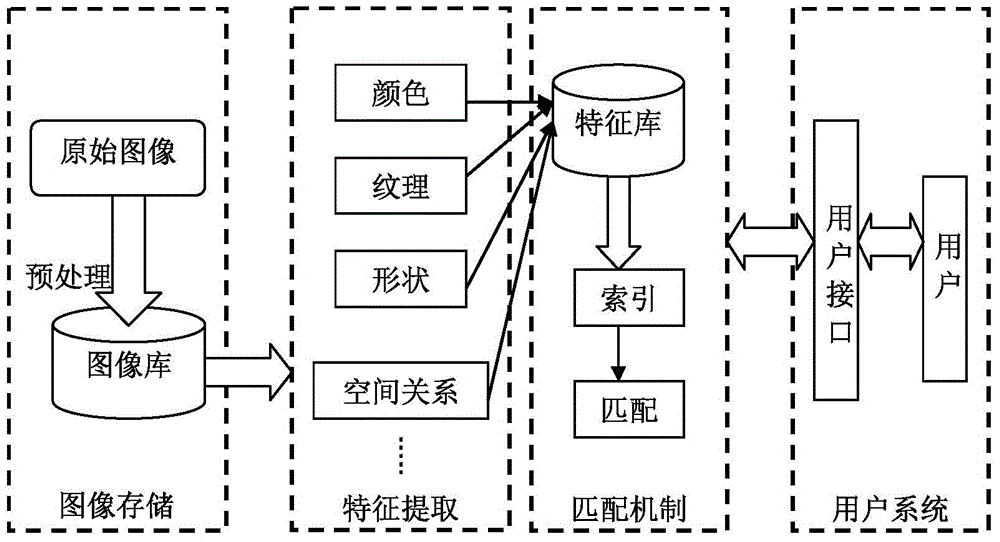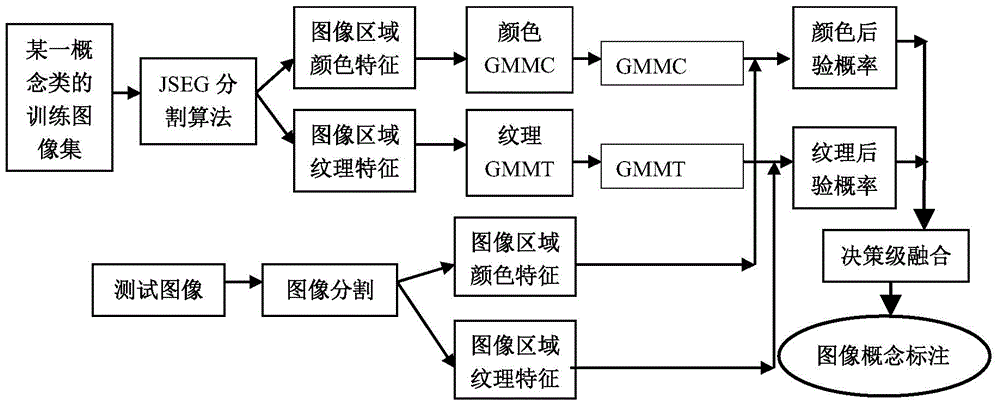Method for marking picture semantics based on Gauss mixture model
A Gaussian mixture model, semantic annotation technology, applied in character and pattern recognition, instruments, computer parts and other directions, can solve problems such as semantic gap
- Summary
- Abstract
- Description
- Claims
- Application Information
AI Technical Summary
Problems solved by technology
Method used
Image
Examples
Embodiment 1
[0095] Example 1: Partial examples of image segmentation, underlying feature extraction, and feature selection modules
[0096] Specific steps;
[0097] 1. Select a semantic concept from the provided image library, each semantic concept includes 200 images;
[0098] 2. Analyze the image color and quantify it.
[0099] 3. Carry out spatial segmentation on the color-quantized image to obtain a set of similar points of any shape, that is, the segmented image area.
[0100] 4. Extract color features, obtain 3-dimensional main color features, and the mean and variance of H, S, and V components in each image area, a total of 9-dimensional feature vectors.
[0101] 5. Extract texture features, obtain the mean and variance of Gabor wavelet coefficients in 4 scales and 6 directions, a total of 48 dimensional regional texture feature vectors.
[0102] 6. Integrate the image features and store them in the image feature library.
[0103] 7. Sampling the image feature library to genera...
Embodiment 2
[0107] Example 2: Partial examples of training
[0108] Specific steps such as Image 6 shown;
[0109] (1) Obtain the optimized image feature library according to the method of embodiment 1;
[0110] (2) Input the feature parameter extracted in (1) to the GMM trained, and seek its likelihood;
[0111] (3) the weighted summation of the matching probabilities of each characteristic parameter obtained in (2) to obtain the total matching degree Match;
[0112] (4) Compare the obtained Match with the threshold. If it is greater than the threshold, the contribution rate of each feature will be calculated; if it is less than the threshold, it will be counted and sent to the end judgment;
[0113] (5) Send back the feature whose Match in (4) is less than the threshold and does not meet the end condition for a new round of training; if the end condition is met, the training ends.
Embodiment 3
[0114] Embodiment 3: Some examples of semantic annotation:
[0115] The specific steps are shown in Figure 7;
[0116] (1) Obtain the optimized image feature library according to the method of embodiment 1;
[0117] (2) Input the feature parameters extracted in (1) into the trained GMM matrix to obtain the likelihood corresponding to each feature;
[0118] (3) According to the likelihood obtained in (2), obtain the probability of matching for each type of feature;
[0119] (4) The probability weighted summation corresponding to all features is used as the total matching Match;
[0120] (5) Compare the obtained Match with the threshold, if it is greater than the threshold, the contribution rate of each feature will be calculated; if it is less than the threshold, it will be counted and sent to the end judgment.
PUM
 Login to View More
Login to View More Abstract
Description
Claims
Application Information
 Login to View More
Login to View More - R&D
- Intellectual Property
- Life Sciences
- Materials
- Tech Scout
- Unparalleled Data Quality
- Higher Quality Content
- 60% Fewer Hallucinations
Browse by: Latest US Patents, China's latest patents, Technical Efficacy Thesaurus, Application Domain, Technology Topic, Popular Technical Reports.
© 2025 PatSnap. All rights reserved.Legal|Privacy policy|Modern Slavery Act Transparency Statement|Sitemap|About US| Contact US: help@patsnap.com



